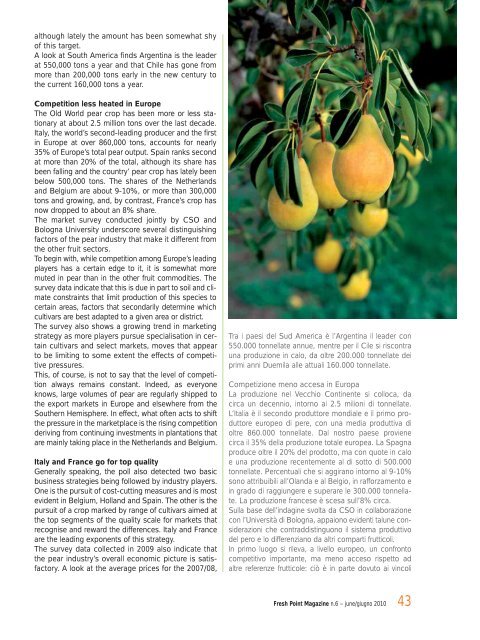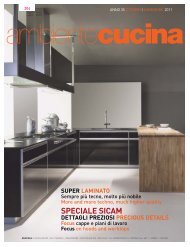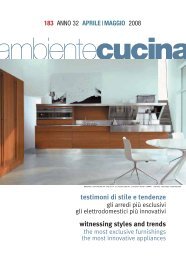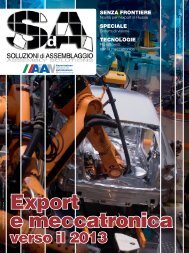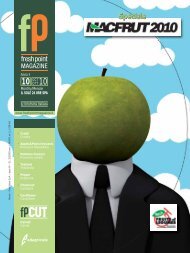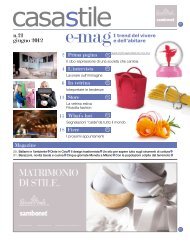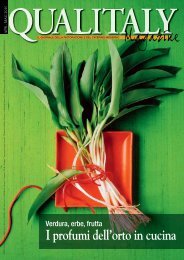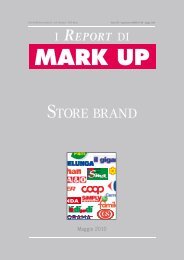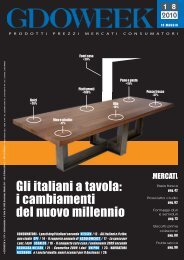Fresh Point Magazine - B2B24 - Il Sole 24 Ore
Fresh Point Magazine - B2B24 - Il Sole 24 Ore
Fresh Point Magazine - B2B24 - Il Sole 24 Ore
You also want an ePaper? Increase the reach of your titles
YUMPU automatically turns print PDFs into web optimized ePapers that Google loves.
although lately the amount has been somewhat shy<br />
of this target.<br />
A look at South America finds Argentina is the leader<br />
at 550,000 tons a year and that Chile has gone from<br />
more than 200,000 tons early in the new century to<br />
the current 160,000 tons a year.<br />
Competition less heated in Europe<br />
The Old World pear crop has been more or less stationary<br />
at about 2.5 million tons over the last decade.<br />
Italy, the world’s second-leading producer and the first<br />
in Europe at over 860,000 tons, accounts for nearly<br />
35% of Europe’s total pear output. Spain ranks second<br />
at more than 20% of the total, although its share has<br />
been falling and the country’ pear crop has lately been<br />
below 500,000 tons. The shares of the Netherlands<br />
and Belgium are about 9-10%, or more than 300,000<br />
tons and growing, and, by contrast, France’s crop has<br />
now dropped to about an 8% share.<br />
The market survey conducted jointly by CSO and<br />
Bologna University underscore several distinguishing<br />
factors of the pear industry that make it different from<br />
the other fruit sectors.<br />
To begin with, while competition among Europe’s leading<br />
players has a certain edge to it, it is somewhat more<br />
muted in pear than in the other fruit commodities. The<br />
survey data indicate that this is due in part to soil and climate<br />
constraints that limit production of this species to<br />
certain areas, factors that secondarily determine which<br />
cultivars are best adapted to a given area or district.<br />
The survey also shows a growing trend in marketing<br />
strategy as more players pursue specialisation in certain<br />
cultivars and select markets, moves that appear<br />
to be limiting to some extent the effects of competitive<br />
pressures.<br />
This, of course, is not to say that the level of competition<br />
always remains constant. Indeed, as everyone<br />
knows, large volumes of pear are regularly shipped to<br />
the export markets in Europe and elsewhere from the<br />
Southern Hemisphere. In effect, what often acts to shift<br />
the pressure in the marketplace is the rising competition<br />
deriving from continuing investments in plantations that<br />
are mainly taking place in the Netherlands and Belgium.<br />
Italy and France go for top quality<br />
Generally speaking, the poll also detected two basic<br />
business strategies being followed by industry players.<br />
One is the pursuit of cost-cutting measures and is most<br />
evident in Belgium, Holland and Spain. The other is the<br />
pursuit of a crop marked by range of cultivars aimed at<br />
the top segments of the quality scale for markets that<br />
recognise and reward the differences. Italy and France<br />
are the leading exponents of this strategy.<br />
The survey data collected in 2009 also indicate that<br />
the pear industry’s overall economic picture is satisfactory.<br />
A look at the average prices for the 2007/08,<br />
Tra i paesi del Sud America è l’Argentina il leader con<br />
550.000 tonnellate annue, mentre per il Cile si riscontra<br />
una produzione in calo, da oltre 200.000 tonnellate dei<br />
primi anni Duemila alle attuali 160.000 tonnellate.<br />
Competizione meno accesa in Europa<br />
La produzione nel Vecchio Continente si colloca, da<br />
circa un decennio, intorno ai 2.5 milioni di tonnellate.<br />
L’Italia è il secondo produttore mondiale e il primo produttore<br />
europeo di pere, con una media produttiva di<br />
oltre 860.000 tonnellate. Dal nostro paese proviene<br />
circa il 35% della produzione totale europea. La Spagna<br />
produce oltre il 20% del prodotto, ma con quote in calo<br />
e una produzione recentemente al di sotto di 500.000<br />
tonnellate. Percentuali che si aggirano intorno al 9-10%<br />
sono attribuibili all’Olanda e al Belgio, in rafforzamento e<br />
in grado di raggiungere e superare le 300.000 tonnellate.<br />
La produzione francese è scesa sull’8% circa.<br />
Sulla base dell’indagine svolta da CSO in collaborazione<br />
con l’Università di Bologna, appaiono evidenti talune considerazioni<br />
che contraddistinguono il sistema produttivo<br />
del pero e lo differenziano da altri comparti frutticoli.<br />
In primo luogo si rileva, a livello europeo, un confronto<br />
competitivo importante, ma meno acceso rispetto ad<br />
altre referenze frutticole: ciò è in parte dovuto ai vincoli<br />
<strong>Fresh</strong> <strong>Point</strong> <strong>Magazine</strong> n.6 – june/giugno 2010<br />
43


